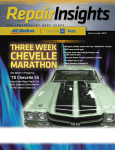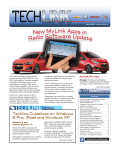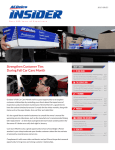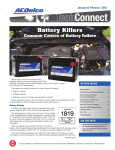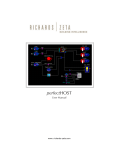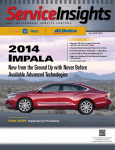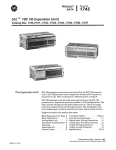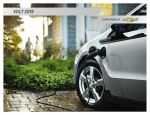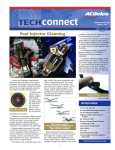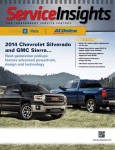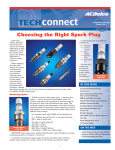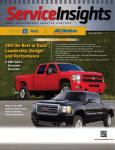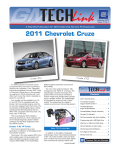Download April/June 2010 - GM Service Insights
Transcript
ServiceInsights F O R I N D E P E N D E N T S E R V I C E C E N T E R S April–June 2010 > Shop GM Performance Parts for the Proven and the New > New and improved transmission fluid replaces Dexron III > Program offers head to head pricing on 200 GM Engine and 400 GM Transmission part numbers > It’s almost time to Volt > Chevy Suburban – 75 great years and counting See Work in Progress. ’70 Chevelle SS Goes from Base Stock Car with Original Sheet Metal to 430 Horse Show Car. CONTENTS GM Parts Product Update 3 The Technical Side The latest word on product development and technologies. 7 Discover new ways to approach service and repairs. Repair Industry News & Updates 5 Business of Repairs Get state-of-theindustry perspectives from GM insiders. 10 New ideas that can benefit how your shop operates and profits. GM ServiceInsights Online GM Performance Parts Crate Engines GM Performance Parts crate engines offer uncompromised performance, plug-and-play installation, and an unmatched value. How can you go wrong? Don't waste your time and money rebuilding a tired, old engine. - 2-year/50,000 miles* limited warranty (*Warranty covers both parts and labor) Only $1,899.00 290 HP 350 Crate Engine Great option for truck or car engine replacement! K CONTACT YOUR GM DEALER More Genuine GM Parts resources and links. Download this issue of GM ServiceInsights and past issues of Movin’ Parts magazine. www.gmserviceinsights.com GM ServiceInsights Headquarters 2604 N.E. Industrial Dr., #230 N. Kansas City, MO 64117 E-mail: [email protected] Compliments of your GM dealer. We invite your input and suggestions. Please address letters to the editor to the above address. Letters submitted imply the right to edit and publish. Every effort is made to ensure the accuracy of the information in the offers contained in this magazine. However, printing and typographical errors may occur. These are not intentional and are not the responsibility of GM, any GM dealer, or the companies or individuals who create, produce and distribute this magazine. Offers and pricing may change at any time without prior notification. The descriptions and specifications in this publication were in effect at the time of approval for printing. General Motors reserves the right to change specifications without notice and without obligation. Published letters do not necessarily reflect the opinions of General Motors, General Motors Parts, General Motors Company, Detroit, MI 48202. 2010 GM Company. All rights reserved. Product Update SHOP GM PERFORMANCE PARTS FOR THE PROVEN AND THE NEW With spring in the air and open road beckoning, GM performance car-lovers may be thinking about powertrain makeovers. If you count some of them among your customers, GM Performance Parts has some products that might make some hearts skip a beat or two. One good choice might be the 350/290HP #12499549. Offering outstanding performance and value, it’s the bestselling small block in the GMPP lineup. It can be a better bet than a costly rebuild, and it offers all the power needed: 290 HP @ 5,100 rpm and 320 lb-fit of torque and 3,750 rpm. The new 350/290HP #19244450 offered from GMPP is also offered as a deluxe crate engine. It includes an aluminum intake manifold and an attractive chrome dress-up kit consisting of chrome valve covers, chrome air cleaner, chrome timing chain cover and chrome breather cap. 350/290HP Dyno Chart Another can’t-miss crate engine solution is the enhanced LS327 (5.3L) #19165628. With a newly available performance camshaft and Graftal-coated pistons, this engine that builds on the legendary Chevrolet small-block V-8 cranks out in excess of 350 HP and 340 lb.ft. of torque. The package, which includes a carbureted intake manifold, gaskets and bolts, and ignition coils, brackets and plug wires, is a simple, yet powerful introductory LS engine for any street project. Both the LS327 and the 350/290HP #19165628 come with the GM Performance Parts 2-year/50,000-mile standard warranty. GM Performance And what good would it be to Parts LS327 show off an LS-series engine without Crate Engine the finishing touches? GMPP’s new collection of LS valve covers give the perfect performance look and feel that any project car demands. Continued on page 4. Apr – Jun 2010 ServiceInsights 3 Product Update (cont’d.) Seven styles are available in a mix of natural, polished and chrome finishes, and callouts are available for favored nameplates and vehicles. Nothing finishes off your engine like a great-looking set of valve covers straight from GM. Replacement for DEXRON®-III New and improved DEXRON transmission fluid available The best transmission fluid for GM vehicles has gotten better. A new-generation DEXRON® product — DEXRON®-VI ATF — is now available to offer even better protection for all Hydramatic transmissions in GM vehicles. They’re designed and built to production specifications and include a production-type O-ring gasket for a leak-free fit. Nameplates include two Corvettes (red and black lettering) and one each for generic Chevrolet, Camaro, Pontiac and GM Performance Parts/LSX. The GMPP Commitment GM Performance Parts crate engines undergo extensive full-power engine dynamometer validation that requires the engines to perform from peak horsepower to peak torque. That commitment to quality and durability enables General Motors to back GM Performance Parts crate engines with a 24-month/50,000-mile warranty (whichever occurs first). All GM Performance Parts components carry a 12-month/12,000-mile warranty. To shop for GMPP products, or for more information, contact your GM Dealer or visit www.gmperformanceparts.com. 4 Apr – Jun 2010 ServiceInsights Replacing DEXRON®-III, the new GM-branded and — approved fluid offers improved performance in a number of key areas, making it the new best choice for virtually all GM vehicles. The new product delivers on all of the criteria for transmission performance and protection, assuring shops and vehicle owners that GM transmissions will operate properly. Higher Performance, Better Wear The result is more consistent shifting performance, from less clutch shudder in modulated torque converters to smoother shifting during low temperature operation. And it also translates to better wear protection. There’s less sludge and deposit formation, improved oxidation and thermal stability and less wear on bushings, bearings and gears due to enhanced foam control. DEXRON®-VI is not just a bit better; it’s a vast improvement, offering 200 percent more shear stability, 150 percent better foam/aeration, 120 percent better clutch durability and two-fold improvement in clutch friction stability and fluid oxidation. With the release of the product, shops should use it in 2005 and prior GM vehicles that now use the earlier generation fluid. And vehicles 2006 and newer, DEXRON®-VI must be used. It is fully back serviceable for DEXRON –III, III (H) and IIE applications and meets GM specification GMN10060. Repair Industry News & Updates Genuine GM Parts Powertrain overPOWER Program Targets Aftermarket If price has ever stood in the way of you choosing GM OE Engines and Transmissions for your customers, it’s about to change. The new overPOWER program includes over 200 Engine and 400 Transmission part numbers from Genuine GM Parts now available with incredible savings from your GM Dealer. This new conquest program is designed to meet the aftermarket competition head-on with GM quality, and aggressive pricing. overPOWER makes it easier than ever to make the best powertrain choice for you and your customer. Start Saving with your GM Dealer When you have a repair or replacement job, make your GM Dealer your first and last call. The overPOWER program gives GM Dealers the power to sell engines and transmissions at prices most of the aftermarket competition can’t best. If you already have an aftermarket quote, call your GM Dealer and put the overPOWER program to the test for yourself. The program is ideal for ISCs who want to give their customers the superior design, performance, warranty and support that comes with every GM Powertrain product. Those are the features your customers value most when looking for replacement powertrain. While the GM lineup of eligible products includes both new and remanufactured engines and transmissions, in many cases a new GM engine can come in at a price that’s competitive with an aftermarket reman. Associated Parts Covered The overPOWER program also extends to associated parts. To assist in making quality GM Parts a value proposition on your engine and transmission installs, your dealer can discount $50 off your associated parts order. Call your GM Dealer for details and/or to place an order. Since its unveiling as a pilot program last November, overPOWER has caught on with more GM Powertrain dealers. The number of qualifying engines and transmissions has grown to the point where most of the high-volume, in-demand products are included. The GM Performance Parts 427 Anniversary Engine Is also included in the program. Apr – Jun 2010 ServiceInsights 5 SPECIAL INSERT Repair Industry News & Updates (cont’d.) Automotive Service & Repair Week The days of automotive service and repair professionals getting lost in the shuffle of the annual Automotive Aftermarket Industry Week (AAIW) events in Las Vegas are ending. This year, the International Autobody Congress & Exposition (NACE) and the Congress of Automotive Repair & Service (CARS) events, which comprise Automotive Service & Repair Week (ASRW), will be staged in October at the Mandalay Bay Convention Center. For the last three years ASRW has been staged under the broader aftermarket parts and service industry umbrella of AAIW, held each November. This year, collision repair and automotive service professionals only will gather Oct. 11-13 (Monday-Wednesday) for traditional educational sessions and product- and service-vendor expositions. ASRW also incorporates Auto Glass Week, dedicated to the automotive glass professional. ASRW sponsor Automotive Service Association (ASA) says moving CARS and NACE to its own time slot will ultimately serve the industry better. ASA President Ron Pyle says a stand-alone ASRW will allow for more focus on 6 Apr – Jun 2010 ServiceInsights Gets Its Own Spotlight matters of interest to service professionals and will appeal to a broader cross-section of the automotive repair industry. “We’re pleased that our plans to produce a dedicated event for all automotive service and repair professionals, regardless of industry affiliation, business model, specialty or discipline, have finally come to fruition,” he says. “Our mission is to make ASRW the only destination necessary to address the needs of the professional service and repair community.” Look for the Genuine GM Parts Exhibit at NACE Oct. 11-13 at the Mandalay Bay Convention Center, Las Vegas naceexpo.com March & April 2010 Fine Tuning Engine The cam phaser allows the PCM to change the relationship of the camshaft relative to the crankshaft, permitting better control over emissions and performance. Splined Phaser with Variable Valve Timing As emissions standards continue to grow stricter, more devices have been added to vehicles to decrease pollutants, ranging from the catalytic converter to exhaust gas recirculation (EGR) and variable valve timing (VVT). Many of these innovations have focused only on emissions; however, variable valve timing has provided a way to help control major pollutants while increasing torque and horsepower through finer control of engine operation. At engine combustion chamber temperatures above 2500°F, nitrogen mixes with oxygen to form oxides of nitrogen (NOx), a major contributor to smog. Because each cylinder experiences combustion temperatures well above that level, a goal for all automotive manufacturers has been to reduce combustion temperatures. The use of an EGR valve was an early method for reducing the formation of NOx. Exhaust gas is reintroduced into the intake manifold through a valve, diluting the intake charge and effectively reducing combustion chamber temperatures and the formation of NOx. A side effect of introducing external EGR to reduce NOx is that it causes the hydrocarbon (HC) levels to increase. Internal EGR A more effective method of controlling emissions is to increase intake and exhaust valve overlap, a version of internal EGR. Valve overlap refers to the amount of time in the four-cycle engine event when both the intake and exhaust valves are open. A reversion occurs in the cylinder as the piston is moving down while both valves are open. Exhaust gas is drawn back into the cylinder, simulating an EGR function. Being able to control the length of this event can substantially lower NOx. HC levels are also reduced by re-burning the tail of the exhaust event that is rich in hydrocarbons. However, placing the camshafts in a permanently increased overlap position would affect idle and low rpm performance. The greater the overlap, the lower the intake manifold vacuum levels. Fixed camshafts compromise between smooth idle, good low-rpm torque and high-rpm power. But variable camshaft timing accommodates the sometimes divergent needs for power, driveability, economy and emission control. Variable valve timing uses a cam phaser to dynamically change valve timing events relative to piston timing by controlling the camshaft. This allows the position of the camshaft to be changed, dependent on need. At idle and low engine load, overlap is minimum, improving idle quality. At higher engine speed and load, overlap is increased, allowing emissions to decrease. Early cam phasers used a splined phaser, which uses an internal piston that connects the exhaust camshaft and cam phaser sprocket together using helical splines, forming an adjustable mechanical link. The swivel action of the cam phaser (or Exhaust Camshaft Position Actuator) is accomplished via oil pressure applied by an oil control solenoid into the actuator’s piston in the hub of the camshaft sprocket. A PCM commanded control valve manages the oil pressure to the cam phaser internal piston. The internal piston rides along the helical splines, rotating the cam phaser gear and the camshaft opposite of each other, changing cam timing. continued on page 2 IN THIS ISSUE Fine Tuning Engine Performance with Variable Valve Timing . . . . . . . . . . . . . .1 The A/C Climate Protection Pledge . . . . . .3 ASE Certification Tests . . . . . . . . . . . . . . . . .3 Battery Charging Guidelines . . . . . . . . . . . .4 Remanufactured Rotating Electrical Product Upgrades . . . . . . . . . . . . . . . . . . . . .5 Controlling Diesel Emissions. . . . . . . . . . . . .6 Tech Tips . . . . . . . . . . . . . . . . . . . . . . . . . . . . .7 Training Update . . . . . . . . . . . . . . . . . . . . . . .8 ON THE WEB – www.acdelcotechconnect.com, click the TechConnect Magazine link, or – Log in to the ACDelco LMS, click the Resources link Variable Valve Timing — continued from page 1 PWM oil control valve (OCV) controls which cavity receives pressurized oil. New vane phaser systems feature an electromagnetic coil situated on the oil control valve, mounted directly on the front of the camshaft. Intake Camshafts Spline phaser system A spring within the cam phaser holds the piston in an advanced position (0°) when no oil pressure is applied. This allows the engine to start and run with the cam in the home position. When cam phasing is desired, the PCM can retard the cam position up to 25° (50° of crankshaft angle) by varying oil pressure to the piston through the control valve. Exhaust cam phasing benefits are reduced emissions and greater fuel economy, however, intake cam phasing provides increased low-end torque and high-end power. Instead of moving the intake cam to effect overlap in the exhaust stroke, intake closure is delayed at the bottom of the intake stroke. At lower speeds, an open intake valve during the first few Publisher: Mike DeSander ACDelco E-mail [email protected] Editor: Mike Militello ACDelco E-mail [email protected] Technical Editor: Production Manager: Marie Meredith Driveability conditions can be caused by any oil debris on the oil control valve/solenoid. degrees of compression can lead to air being pushed back out the intake valve as the piston moves upward. But at higher speeds, the open intake valve allows the air that’s been moving into the cylinder to keep coming in under the momentum the air charge has acquired. The result is a cylinder with greater volumetric efficiency. Desktop Publishing: 5by5 Design LLC E-mail [email protected] Write to: ACDelco TechConnect P.O. Box 500 Troy, MI 48007-0500 On the Web: To read and search recent issues of TechConnect online: – www.acdelcotechconnect.com, click the TechConnect Magazine link, or – Log in to the ACDelco LMS, click the Resources link Vane phaser At idle, the exhaust cams operate at full advance, for minimum valve overlap. Optimizing valve overlap eliminates the need for a separate EGR system and air injection reaction (AIR). The camshafts are driven by a roller chain. A hydraulically operated tensioner keeps proper tension on the chain, even as it stretches with mileage (a normal occurrence in all chains), which eliminates need for periodic replacement or adjustment. The cams operate directly on roller-finger followers, which actuate the valves. A return spring sits under the reluctor of the actuator to help keep it at a 0° (home) position. The actuator contains two cavities for oil to flow into to either retard or advance the cam. The four-way ACDelco TechConnect is published bi-monthly and online for technicians of Total Service Support (TSS) and Key Fleet accounts to provide timely service information, increase knowledge and improve the performance of the service center. Mark Spencer E-mail [email protected] Vane Phaser Later VVT systems on some twin-cam engine designs use a vane phaser on each camshaft. Inside the vane-style actuator assembly are a rotor and stator that are not mechanically linked together. Instead, oil pressure is controlled on both sides of the vanes of the rotor, giving a hydraulic link to the stator. Varying the balance of oil pressure on each side of the vanes is how the cam is phased. Volume 17, Number 2 (TS-PU-0014-10) Exhaust and intake cam phasers Overhead-cam engines that phase both intake and exhaust cams use a vane phaser. Pushrod engines with variable valve timing on their singlecam-in-block engines also use a vane phaser, but these engines differ from overhead-cam engines in that they push the oil control solenoid back into a hollow portion of the front of the camshaft. Four small oil holes are situated in the camshaft to line up with the oil control valve/solenoid. – Thanks to Mike Militello 2 TECH CONNECT 2 ACDelco service tips are intended for use by professional technicians, not a “do-it-yourselfer.” They are written to inform those technicians of conditions that may occur on some vehicles, or to provide information that could assist in the proper service of a vehicle. Properly trained technicians have the equipment, tools, safety instructions and know-how to do a job properly and safely. If a condition is described, it cannot be assumed that the information applies to all vehicles or that all vehicles will have that condition. All materials and programs described in this magazine are subject to change. Submission of materials implies the right to edit and publish. Inclusion in the publication is not necessarily an endorsement of the individual or the company. TechConnect is published for ACDelco by Sandy Corporation, Troy, MI. ©2010 ACDelco. All rights reserved. The A/C Climate Protection Pledge Required Equipment It seems that the marketplace is finally ready to be green. When it comes to vehicle air conditioning service, potential customers are looking for service centers that have highly trained technicians and the proper equipment to provide environmentally friendly air conditioning service. • SAE J2788 RRR Equipment • Refrigerant Identifier • Electronic Leak Detector • Ultraviolet Dye Leak Detecting System • R134a Manifold Gauges The Mobile Air Conditioning Society (MACS) Worldwide and the U.S. Environmental Protection Agency have developed the Automotive A/C Climate Protection Pledge to help qualifying service centers be recognized for their environmental leadership in performing proper environmental mobile A/C service. American interest in the environment has grown recently. According to the 2009 Cone Consumer Environmental Survey: • 35% of Americans have higher interest in the environment today than they did one year ago • 35% of Americans have higher expectations for companies to make and sell environmentally responsible products and services • 70% of Americans indicate that they are paying attention to what companies are doing with regard to the environment today Service centers completing the Automotive A/C Climate Protection Pledge commit to: • Use required tools and equipment • Train technicians in Best Practices • Promote repairing of leaks and discourage recharge of leaking systems • Vacuum Pump (stand-alone or built into R/R/R equipment) • Temperature Measuring Devices (digital thermometer, digital pyrometer, infrared thermometer) • Hose Repair Crimping Tool (if shop makes own hose assemblies) • Spring Lock Coupling Service Tools • Certify that all contaminated refrigerant collected is sent to a certified reclaimer • A/C Fitting Service Tools • Orifice Tube Service Tools • Service Information Resources (manuals, specification books, computerized information, etc.) • Set continuous improvement goals • Allow EPA to review pledgerelated publicity materials (signs, press releases, advertisements, etc.) before they are released Technician Training • Establish a procedure for removal of refrigerant heels All A/C technicians are encouraged to complete a self-study training program focusing on best practices for leak detection, service and repair, and refrigerant conservation. These practices are designed to promote shop savings and efficiency, consumer satisfaction and environmental protection. • Train service writers or others who greet customers to explain the economic and environmental advantages of having leaks repaired rather than just having the A/C system “topped off” The Best Service Practices Study Course booklet, additional training information, A/C service pledge exam and the pledge application are available on the MACS website at www.macsw.org. • Upgrade R/R/R equipment, leak detectors • Establish a tool and equipment maintenance program Take the Pledge To take the Climate Protection Pledge 1. Go to www.macsw.org and click the Climate Protection Pledge link to download the Best Service Practices Study Course. (All A/C technicians should study this booklet). 2. Log in to the MACS website to take the Auto A/C Climate Protection Pledge Exam and Pledge. (If you’re not a member, log in and create a profile.) There is no charge for the exam. If you have met the requirements, you will be notified, your shop will be added to a “shop locator” list available to mobile A/C repair customers and you will receive information on how you can promote the U.S. EPA’s recognition to mobile A/C repair customers. 3 TECH CONNECT Summer 2010 Computer-Based Tests Registration: July 9 – August 16, 2010 Register by phone ONLY: 1-800-525-6929 Testing Dates: July 16 – August 23 Computer-Based Tests Offered Automobile . . . . . . . . . . . . . . . . A1-A8 Advanced Automobile. . . . . . . . . . . L1 Auto Parts . . . . . . . . . . . . . . . . . . . . P2 Auto Service Consultant. . . . . . . . . . C1 Med/Heavy Truck . . . . . . . . . . . . . T1-T8 Collision . . . . . . . . . . . . . . . . . . . B2-B6 Go to www.ase.com for more information. Battery Charging Guidelines A customer with a “bad” battery typically expects something to be done about it immediately. The customer may not understand that the battery may be “good” but simply discharged. Customers who want to get back on the road quickly may demand a new battery under warranty. There are two things wrong with this approach. First, if the battery is otherwise serviceable, it may only need a recharge to return it to health. Second, unless the cause that discharged the battery is resolved, neither a new battery nor recharging the original battery will solve the real problem. The technician’s job is to recharge the battery quickly and safely, and determine and repair the cause of the battery becoming discharged. Testing a battery using a conductance-type tester can determine if the battery is good and can be recharged. Charging Ahead Battery charging involves applying sufficient voltage to the battery to cause current to flow through the battery. Charging causes a chemical change in both the battery’s plates and the electrolyte. If the battery is simply discharged, but otherwise good, applying a suitable current for enough time Conductance testers will eventually can accurately measure fully charge the performance of a the battery as battery in service. much as is chemically possible. However, continued application of current can lead to overheating, loss of electrolyte and shortened battery life. The charging process requires time and current. Multiply the charging rate in amperes by the number of hours and the result will be the ampere-hours of charge applied to the battery. To bring a battery to full charge will require roughly the same number of ampere-hours at a low charge rate as it does at a high rate. Put another way, a higher rate will take less time. Since most customers like to have their vehicles returned quickly, it’s desirable to get the charging job done quickly by using a high charge rate. State of Charge It’s not possible to measure a battery’s state of charge in ampere-hours, so another method must be used. Open circuit voltage (OCV), measured across the battery’s terminals, relates to the battery’s state of charge. The voltmeter must be capable of reading to the nearest 0.01 volt. If the battery has not been charged or used (the engine started or the vehicle driven) in the last 12 hours, a reading may be taken. If the battery has been discharged and recharged or used within the last 12 hours, connect a carbon pile and load the battery at 300 amperes for 15 seconds. Remove the load. Wait 15 seconds and then take the reading. The OCV reading is accurate +/10%. A battery with a state of charge of 65% or greater is marginally charged enough to be returned to service. However, if the vehicle will be used in slow traffic or short drive times, or in very cold or very hot conditions, the battery should be at least 90% of full charge before returning to service. Automatic Battery Chargers Advancements in battery charging technology now combine diagnostics and charging control systems that monitor and automatically regulate the charging process. These controls maximize the chargers output based on the battery status, while protecting the battery from overcharge. This means you can use chargers with the highest output ratings, so long as the charger makes the necessary adjustments as the battery approaches full charge. Automatic battery chargers such as the Midtronics GR1, Associated Intell/Matic Pro or the Cristie PDQ can return a good, but discharged, battery to at least 85% state of charge in 20 to 40 minutes. Manual Battery Chargers Non-automatic battery chargers do not offer the self-limiting features of the latest equipment. It is the operator’s responsibility to control the charging process. continued on page 5 State of Charge OCV (conventional flooded-cell battery OCV (AGM battery) % charge at 32°F (0°C) % charge at 75°F (25°C) 12.75 12.8 100% 100% 12.70 — 100% 90% 12.60 — 90% 75% — 12.6 100% 75% 12.45 12.4 75% 65% 12.20 12.3 65% 45% 12.00 12.1 40% 20% 4 TECH CONNECT Remanufactured Rotating Electrical Product Upgrades Monitor both charging current and voltage every 30 minutes. Because voltage is not held constant, it will rise as the battery becomes charged. The ACDelco brand stands for quality. To further enhance that reputation in the remanufactured rotating electrical aftermarket, ACDelco has announced product upgrades to Line 33 Alternators and Starters. When voltage reaches 16 volts, reduce the charging current to 5 amperes. When the voltage reaches 16 volts again, at the 5 amp current, the battery is fully charged. Dead Cold Midtronics GR1 automatic battery charger A completely discharged battery will take more than twice as long as a half-charged battery to bring the battery to a usable state of charge. The electrolyte in a discharged battery is largely water, which is a poor conductor. The battery may accept such a small amount of current at first that it appears not to take a charge. Also, chemical reactions in a battery are slower at low temperatures, so a very cold battery will take longer to charge than one at room temperature. AGM Batteries The Absorbent Glass Mat (AGM) battery uses absorbent glass mats to hold a small amount of electrolyte in contact with the plates. The battery uses a gas recombinant technology, where the gases produced at the plates are recombined to form water before they escape. This battery design offers high power for lower weight and is more resistant to high temperatures, vibration and cycling. The AGM battery may be charged using an automatic battery charger, as long as the charger automatically adjusts the charging current as the battery nears full charge. When using a conventional charger, limit the rate to 10 amperes or less. Do not allow the battery to charge at 3 amperes or more for longer than 10 hours, or 10 amperes for longer than 5 hours. When these limits are reached, allow the battery to stand overnight, and then resume charging if further charging is required. Check the voltage every 30 minutes and remove the battery from charge when the voltage reaches 15 volts at 3-10 amperes. The state of charge should be at 90–95%. Refer to GM bulletin #02-06-03-009C for additional information on battery charging. – Thanks to Mike DeSander On many top selling parts in the remanufactured product line, ACDelco will use 100% new regulators on alternators The gold sticker supports ACDelco quality. and 100% new solenoids on starters. These product upgrades make ACDelco the only brand using 100% new regulators and solenoids in our most popular remanufactured parts. New Quality Label The upgraded product will be easy to identify with the addition of a gold quality sticker applied to the top of the box. The upgraded products will be shipped automatically as new orders for alternators and starters are processed. Root Cause When making repairs on rotating electrical systems, in-depth diagnosis is needed before parts replacement, including checking other components and conditions that might affect system performance, such as any Diagnostic Trouble Codes, battery health and fluid contamination Fluid contamination is often the root cause of the failure of starters. For instance, oil intrusion into a starter will degrade the brushes to the point where they will not make good electrical contact with the armature/commutator. Inspect the old starter; if it appears to be oil soaked, repair the source of the leak (i.e. valve covers, intake valley, etc.). Fixing the oil leak will reduce the chance of a customer comeback. More Information For more information on how to prevent early failures of alternators and starters, check out the Comeback Prevention seminar (S-DS1101.01SEM). To learn more about the latest technology used in modern charging and starting systems, attend the Advanced Charging and Starting Systems Diagnostics seminar (S-EL06-20.01SEM). Contact your local ACDelco distributor to learn when a seminar will be held in your area. – Thanks to Bob Malone 5 TECH CONNECT 6 TECH CONNECT The following technical tips provide repair information about specific conditions on a variety of vehicles. If you have a tough or unusual service repair, the TSS Technical Assistance Hot Line can help. Call 1-800-825-5886, prompt #2, to speak with a technical expert with the latest OEM information. Fluid Flushing Requirements and later systems, a clear or “dark” LED may indicate the OnStar system has been deactivated or may possibly 2005-2010 Chrysler, Dodge and Jeep vehicles Chrysler Group vehicle fluid systems do not require regular flushing. These systems include: engine oil, transmission oil, axle lube, brake fluid, power steering fluid, and refrigerant. The only exception to this requirement are those fluid changes that are published in the vehicle maintenance schedules, e.g. engine coolant, and in instances where a failure has occurred and/or the system has become compromised, contaminated or overheated beyond the normal operating range. Aftermarket chemicals to flush the engine, transmission, brake or steering systems are not recommended. Chemicals contained in these products can damage the system elastomeric components, and contaminate the component fluid, leading to loss of system/component durability and service life. When necessary, only the original approved system fluid should be used to flush these components using approved equipment. If the engine coolant contains a considerable amount of sediment, clean and flush the system followed by a thorough rinsing to remove all deposits and chemicals. Refill with a minimum of a 50% mixture of the specified coolant and distilled water. To grease the springs, pressure wash the springs to remove as much dirt and debris as possible and dry the springs with compressed air. Apply a liberal amount of grease under the front and rear tip inserts for the #2 and #3 leaves, on top of the tip inserts, and in between the #1 and #2, and #2 and #3 leaves. have a no power concern/no communication. The OnStar system will stay powered up after the ignition is off for an extended time in order to allow for remote services like door unlock, horn chirp, light flash, etc., to take place as requested by the driver. Power cycle times vary depending on the generation of the OnStar system, and may be powered up continuously from 48 hours to 120 hours after the ignition is off. Technicians may identify the system generation by using a scan tool or by using www.onstarenrollment.com. The expected current draw of the OnStar module is: IGN ON - 240 to 400 mA IGN OFF - 3 to 20 mA for 48 hours IGN OFF - after 48 hours (120 hours on specified VCPs) - 0.2 to 0.8 mA Refer to Chrysler bulletin #26-001-09 for more information. Squeak Noise from Rear of Vehicle OnStar® Power Consumption 1999-2007 Chevrolet Silverado (Classic), GMC Sierra (Classic); 20072009 Chevrolet Colorado, Chevrolet Silverado, GMC Canyon, GMC Sierra, HUMMER H3, HUMMER H3T 2000-2010 OnStar-equipped Vehicles with Digital Hardware During battery parasitic drain testing, it is important to understand the power cycles of the various OnStar systems in order to avoid confusion about normal power consumption readings. All OnStar customers with currently active vehicles have digital/analog cellular capability. A green status LED on the OnStar keypad normally indicates an active OnStar account. A red LED indicates a system DTC. On Gen 6 grease to the rear leaf springs will correct this condition and do a better job of preventing the noise from reoccurring than replacement of the springs. A squeak noise may be coming from the rear of the vehicle. During normal operation, certain vehicles may exhibit a squeaking noise that may be traced to the rear leaf springs. While this noise is an operating characteristic of leaf springs, the roads that the vehicle is driven on will affect the frequency and severity of this noise. This condition may be due to debris getting between the leaf springs. It has been found that the application of 7 TECH CONNECT Periodic cleanings and grease re-application may be necessary throughout the life of the vehicle. If this procedure does not correct the noise on 1500 Series (1/2 ton) models built prior to October 2004, the noise may be caused by an incorrectly dimensioned splay clip (the band holding the ends of the leafs together) that interferes with the leaf springs. A 5 mm (0.197 in) wider splay clip was introduced early in the 2005 model year to provide additional clearance. To correct this condition, it may be necessary to replace the rear leaf spring assembly. There was no change to the part number. For more information, refer to GM bulletin # 06-03-09-004B. Diagnostic Assistance For free technical diagnostic assistance and product information regarding specific ACDelco products, contact these toll-free information hotlines staffed by ASE-certified technicians: Brakes – 1-888-701-6169 (prompt #1) Chassis – 1-888-701-6169 (prompt #2) Clutches – 1-888-725-8625 Lift Supports – 1-800-790-5438 Shocks – 1-877-466-7752 Starters and Alternators – 1-800-228-9672 Steering – 1-866-833-5567 Wiper Blades – 1-800-810-7096 How to Take ACDelco Training Go to www.acdelcotechconnect.com and click on the Training tab to log on to the ACDelco Learning Management System (LMS). • To enroll in an Instructor-Led Training (ILT) course, click on the Enrollment link or the Instructor-Led Courses link. • To launch a Web-Based Training (WBT) course, click on the Web-Based Courses link to view the catalog and select a specific course. • To launch a TechAssist (TAS) course, click on the TechAssists link to view the catalog and select a specific course. • To launch a Simulation (SIM), click on the Simulations link to view the catalog and select a diagnostic challenge simulation. S-AT02-04.01WBT – Automatic Transmission Diagnosis The processes and procedures for diagnosing automatic transmission concerns are discussed in this web-based course. It discusses the procedure for performing a preliminary inspection, the process for performing a road test, and the procedures used in post-road test diagnosis. S-AT02-05.01WBT – Automatic Transmission Hydraulics and Electrical Systems This web-based course covers the components and operation of the hydraulic system and the electronic controls that drive the hydraulic system, including the functions of the valves located in the fluid pump assembly, the valves located in the control valve body, and the solenoids contained in the solenoid control assembly. The characteristics of the electronic control module, the control module inputs, and the transmission adaptive functions also are reviewed. Current Instructor-Led Training ACDelco’s Instructor-Led Training (ILT) courses provide hands-on instruction on the latest automotive systems. The following ILT courses are currently being held at training center locations around the country. Click the Schedule link on the LMS Menu to search the latest training schedule for courses held in your area. New Training The following ACDelco training programs have recently been made available via the LMS: S-AT02-01.01WBT – Automatic Transmissions This web-based course provides an introduction to automatic transmissions, including automatic transmission specifications, powerflow through an automatic transmission, the characteristics of automatic transmission cases, the proper operation of torque converters, and the function of automatic transmission gear select indicators. S-AT02-02.01WBT – Automatic Transmission Gearset The characteristics and operation of planetary and differential gearsets are covered in this web-based course. Also reviewed in the course is the disassembly and assembly of gearsets as well as how to service differential gearsets. S-AT02-03.01WBT – Automatic Transmission Mechanical Apply Components This web-based course highlights the mechanical and apply components used in automatic transmissions. Topics covered include operation of the 1-2-3-4 clutch, characteristics of the 3-5 Reverse clutch, operation of the 4-5-6 clutch, characteristics of the 2-6 clutch, operation of the Low and Reverse clutch, and Low clutch sprag characteristics. Course Number Course Name S-AC07-02.01ILT Automotive Air Conditioning: Advanced Refrigerant System Diagnostics S-AC07-03.01ILT HVAC Control System Operation and Diagnostics S-AC07-06.01ILT Toyota HVAC S-AC07-07.01ILT Chrysler HVAC S-BK05-01.01ILT Braking Systems S-EL06-04.02ILT Network Communication Diagnosis S-EL06-10.02ILT Electrical Power Management S-EL06-11.01ILT Automotive Electrical Circuit Diagnosis and Repair S-EL06-12.01ILT Hybrid Technology and Service S-EP08-02.01ILT Engine Performance: Computer Controls and Ignition System Diagnostics S-EP08-03.01ILT Engine Performance: Air Induction and Fuel System Diagnostics S-EP08-04.01ILT Engine Performance: Fault Monitoring and Emission System Diagnostics S-EP08-05.01ILT Engine Performance: Advanced Drivability Diagnostics S-EP08-20.01ILT Toyota Engine Performance S-EP08-21.01ILT Chrysler Engine Performance S-EP08-81.01ILT Duramax 6600: Diesel Engine Performance S-SS04-01.01ILT Vibration Correction Diagnostics S-ST10-01.01ILT Supplemental Restraint Systems TS-PU-0014-10 8 TECH CONNECT The Technical Side It’s almost time to Volt. Chevy on the verge of introducing new propulsion technology. Chevrolet is banking on tens of thousands of customers casting their vote later this year in favor of the new Chevrolet Volt, the first Extended Range Electric Vehicle (E-REV) to be produced on a commercial scale. It promises to be a big deal for GM, one that will vault the carmaker to the head of the class in the commercialization of green vehicle technology. Unlike hybrid electric vehicles that use gasoline and electrical systems, the E-REV Volt is powered solely by an electric motor. Its lithium-ion battery, designed to be recharged via a plug-in to the electrical grid or an on-board generator, powers the motor under all speeds and power levels for up to 40 miles. After that, its gas-powered, range-extending generator automatically kicks in to provide electrical power. So Volt can go for several hundred additional miles, until you can plug it in or fill it up again. Indeed, with the Volt, the battery is its main power source. The key to the technology is the sizing of the vehicle, battery and propulsion system so that vehicle operation is not dependent on the engine. In a hybrid, the engine is usually the larger of the two propulsion sources. It all adds up to a vehicle that takes energy savings and environmental friendliness to a new level — without a performance compromise. Volt Links . . . www.chevroletvolt.com Go to the Chevy Volt Web site for the latest news. www.chevroletvoltage.com A way to connect with other electric vehicle enthusiasts. www.facebook.com/chevroletvolt With Facebook, you can join a community of Volt fans. The 2010 75th Anniversary Diamond Edition Chevy Suburban As the first vehicle in the industry to achieve 75 years in production, the 2010 75th Anniversary Diamond Edition Chevy Suburban will go on sale early this summer and is limited to 2,570 units. It is distinguished by a White Diamond Tricoat exterior color and Cashmere interior, along with unique 20-inch chrome-clad wheels and new roof rack rails. Special badging adorns the C-pillar sail panel and steering wheel center cap, while “Diamond Edition” lettering is used on the sill plates and is embroidered on the front headrests. The anniversary models are equipped with LTZ content and are offered in 1500 2WD or 4WD configurations. Apr – Jun 2010 ServiceInsights 7 The Technical Side (cont’d.) From page 7, 75th Anniversary Suburban The content of the 75th Anniversary Diamond Edition Suburban is unique, but it’s built on a foundation of strength and capability that has propelled the brand for more than seven decades. Available Powertrains V-8 with variable valve timing and E85 FlexFuel capability (2500 models). E85 comprises 85 percent ethanol and 15 percent gasoline, reduces greenhouse gas and smogforming emissions, is domestically produced and helps reduce dependence on petroleum. A Vortec 5.3L FlexFuel engine and fuel-saving six-speed automatic transmission are standard in Suburban half-ton models, enabling a maximum towing capacity of 8,100 pounds (2,674 kg). Suburban 2500 models offer a 6.0L/six-speed powertrain combination and a maximum towing rating of 9,600 pounds (4,354 kg). Also available is the Vortec 6.0L 1935 Chevrole t Vortec 6.0L V-8 for the 2010 Chevy Suburban Suburban Repair Procedure for the 2010 Chevy Suburban Even though the 2010 Chevy Suburban is a new vehicle, extensive service and repair information resources are a click away at www.gmtechinfo.com — Electronic Service Information. Technicians and shop owners can log on to the site to gain access to subscription services for service procedures and repair manuals. A complete Service Manual is accessible 24/7 through a subscription to the site. Free collision repair procedures will soon be available by going to www.genuinegmparts.com and clicking on GM Technical Repair Information. This example of Air Conditioning Compressor Belt Replacement (V8) and Drive Belt Replacement – Accessory for the 2010 Chevy Suburban is just one of many found in the Service Repair Manual. By following the proper repair procedures, technicians can ensure that each vehicle maintains its solid performance and uncompromised safety features for the life of the vehicle. 8 Apr – Jun 2010 ServiceInsights Air Conditioning Compressor Belt Replacement (V8) Removal Procedure Remove the accessory drive belt. Refer to Drive Belt Replacement – Accessory. 1 the skid plate. Refer to Engine Shield 2 Remove Replacement. the belt (1) from air conditioning (A/C) 3 Cut and crankshaft pulleys. 1 Installation Procedure Note: The OEM replacement stretchy belt is packaged with a disposable installation tool. Position the belt behind the rear face of the balancer (1) and off of the A/C pulley (2). 1 Removal Procedure 1 3 Install the belt 2 installation tool (3) onto the balancer. Slide the belt installation 3the belt tool (1) upward, installing (2) onto the belt installation tool. 5 Slide the belt installation 4 tool downward, positioning the belt onto the A/C pulley, applying light tension to the belt. Position the lower 5withportion of the belt (1) the ribbed area facing forward. the drive belt (1) around 1pulley.Route all the pulleys except the idler Install the breaker bar with 2 hex-head socket to the belt tensioner bolt. 7 Rotate the balancer (1) 8 an additional 360 degrees to ensure proper belt installation. 9 1 6 the drive belt (1) 7and forInspect proper installation alignment. Install the skid plate. Refer to Engine Shield Replacement. the air cleaner outlet duct. Refer to Air Cleaner 1 Remove Resonator Outlet Duct Replacement. a breaker bar with hex-head socket to the drive belt 2 Install tensioner bolt. Rotate the drive belt tensioner clockwise in order to relieve 3 tension on the belt. the drive belt (1) from the pulleys and the drive 4 Remove belt tensioner. 5 Slowly release the tension on the drive belt tensioner. the breaker bar and socket from the drive belt 6 Remove tensioner bolt. 7 Clean and inspect the belt surfaces of all the pulleys. Installation Procedure Slowly rotate the 6 crankshaft pulley (1) in a clockwise direction while using finger pressure to pull the belt (2) forward. Ensure that the ribbed area of the belt remains facing forward and the belt aligns properly to the A/C pulley. Drive Belt Replacement – Accessory 8 the belt tensioner 3 Rotate clockwise in order to relieve the tension on the tensioner. 4 Install the drive belt under the idler pulley. 5 Slowly release the tension on the belt tensioner. the breaker bar and socket from the belt 6 Remove tensioner bolt. 7 Inspect the drive belt for proper installation and alignment. the air cleaner outlet duct. Refer to Air Cleaner 8 Install Resonator Outlet Duct Replacement. the vehicle and inspect the drive belt for proper 9 Start operation. Close the hood. Install the accessory 10 drive belt. Refer to Drive Belt Replacement — Accessory. Apr – Jun 2010 ServiceInsights 9 Business of Repairs Restorer, Suppliers Rally to Beat The Clock on ’70 Chevelle SS Show Car Project In 30 years of operating a custom hot rod and restoration business, Bob Janda has seen it all. Unusual requests, innovative applications and some pretty unrealistic deadlines. In March, he got all of that at the same time. Janda’s shop, Frame-Up Wheel Works, in Waukegan, Ill., had the honor — and the distinct challenge — of shepherding the resources needed to quickly outfit a show car with one of GM Performance Parts’ revolutionary new E-ROD, emissions-compliant crate engines. In less than three weeks, Janda had located a car, rounded up the necessary parts and marshaled the labor to do a job that might typically take three months. But at the end of the day, he had a glistening 1970 Chevrolet Chevelle outfitted with a ground-breaking “green” high-performance engine to show for his efforts. And show it he did. The car, owned by Chuck Barnes, owner of Nostalgic Auto Body, in nearby Arlington Heights, Ill., made its date with the GM Performance Parts booth at the 13th Annual Hot Rod & 10 Apr – Jun 2010 ServiceInsights Restoration Trade Show in Indianapolis. “Timing was the big thing on the project,” he says. “Three weeks was a killer because I had just lost a guy and I was worried about getting all the parts we needed fast enough. But my employees came through and I was able to call in some favors from suppliers to get it done.” The E-ROD engine, a 6.2L LS3 rated at 430 hp, was the least of his challenges. It came from Gandrud Chevrolet, Janda’s longtime GM Performance Parts supplier, in Green Bay, Wisc. The dealer’s Chris Slack had approached Janda about doing the E-ROD job in time for the Indianapolis showing. Provided he could quickly find a car, Slack said Gandrud would supply the engine. Within a day of lining up the car, a half-done project that had been languishing in Barnes’ shop, Janda had the E-ROD engine. Over the next several days he contacted parts suppliers, but feared order backlogs would be a problem. Instead, they rallied to the cause, expediting the shipment of some $40,000 worth of parts that would be needed to complete the project. While the project was a push to complete, Janda says it wasn’t due to technical problems related to the engine. It installed smoothly, requiring only minor work-arounds. The cross stock member had to be notched and reboxed for adequate oil pan clearance, motor mounts had to be tweaked and the transmission tunnel had to be refashioned for a new 5-speed manual transmission. “It was a mostly plug-and-play installation without a lot of fabrication needed,” he says. “Once we got it completed it started right up and ran smoothly.” With the dealership graciously including the engine, he paid for the parts and Frame-Up’s labor, but handled the E-ROD mint-green paint job himself. With a package that includes a Keisler Engineering five-speed with a hydraulic clutch and drive shaft shifter, Detroit Speed rear suspension, Global West suspension control arms, Rock Valley stainless steel gas tank with an LS-style pump, an AutoRAD custom-built radiator, and a Vintage Air AC Climate System, the Chevelle is a standout example of what can be done with GM’s new E-ROD engine. For more pictures and information on the three week rebirth of the ’70 Chevelle SS, go to frameupwheelworks.smugmug.com/Projects/ChuckBarnes-E-Rod-1970. CONTACT YOUR GM DEALER We’re one stop. For your shop. Genuine GM Parts Engines and Transmissions. Plus, all the associated parts you need. CLIP AND PLACE BY YOUR TELEPHONE Give us a call for Genuine GM Powertrain Parts and associated repair parts. All at one convenient location. Contact your local GM Dealer for all of your Parts needs. Remanufactured Automatic Transmissions Each GM Remanufactured Automatic Transmission passes a series of rigorous tests before it goes into a GM vehicle. GM Remanufactured Transmissions are calibrated for a specific late-model GM vehicle to maintain its original performance. - Up to 3-Year/100,000-mile transferable limited warranty - Technology updated to latest GM standards - Performance tested to ensure proper function 4L60E Only $1,347.00 GM Transmissions are time and money savers with easy plug-n-play installation! K CONTACT YOUR GM DEALER






















